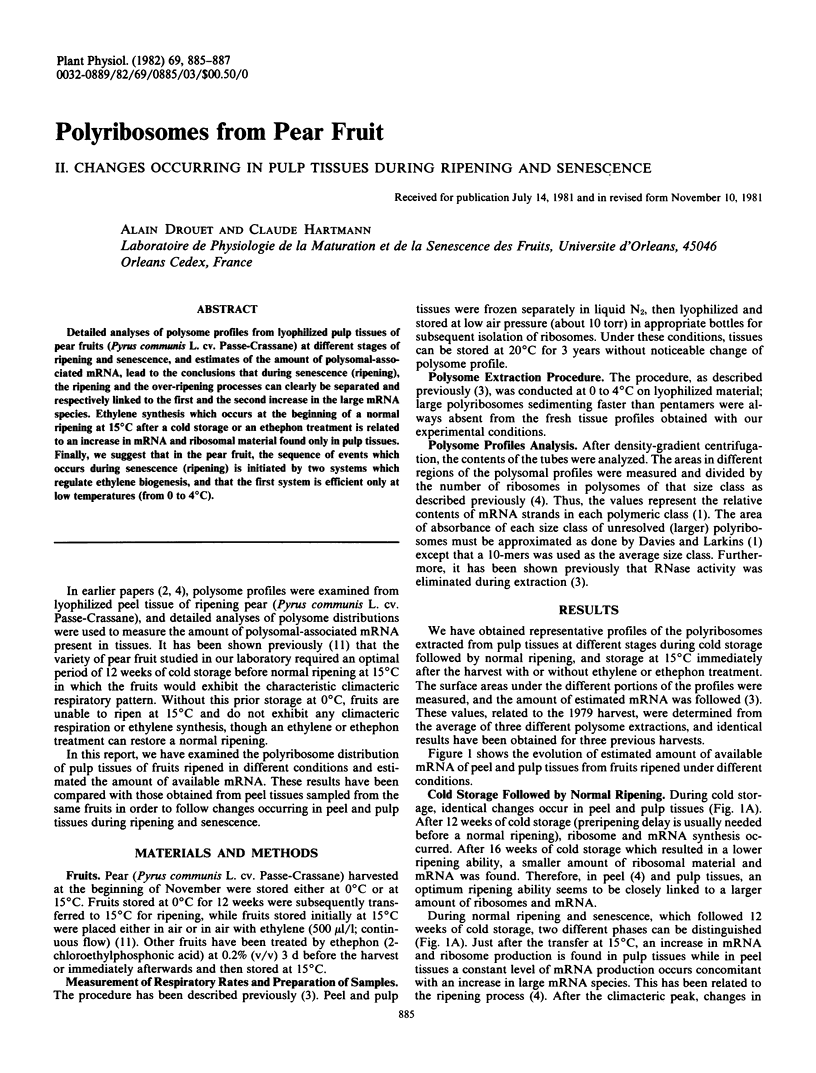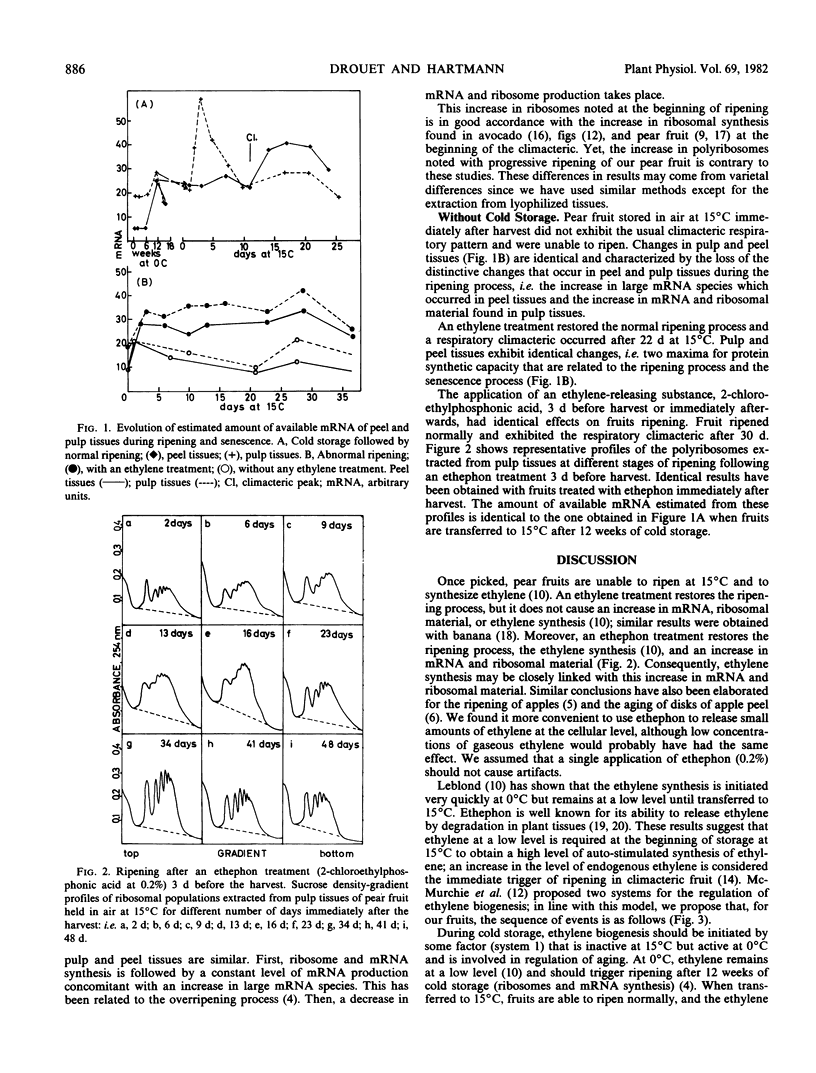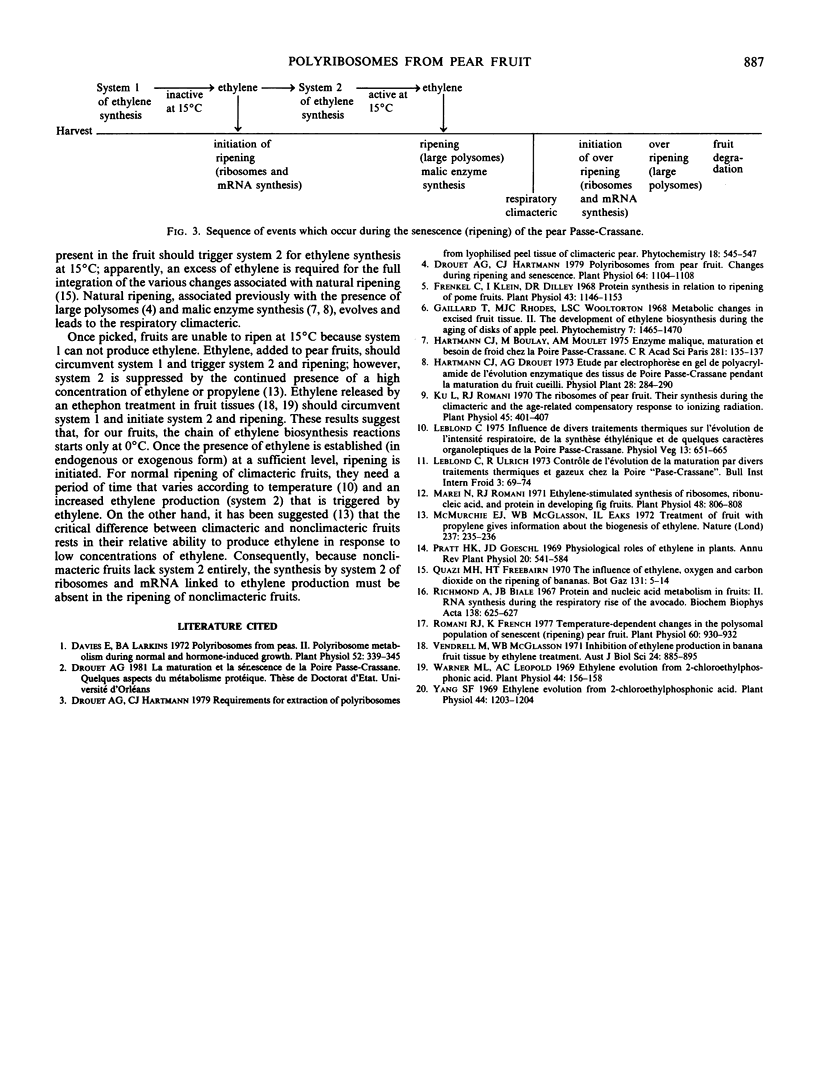Abstract
Detailed analyses of polysome profiles from lyophilized pulp tissues of pear fruits (Pyrus communis L. cv. Passe-Crassane) at different stages of ripening and senescence, and estimates of the amount of polysomal-associated mRNA, lead to the conclusions that during senescence (ripening), the ripening and the over-ripening processes can clearly be separated and respectively linked to the first and the second increase in the large mRNA species. Ethylene synthesis which occurs at the beginning of a normal ripening at 15°C after a cold storage or an ethephon treatment is related to an increase in mRNA and ribosomal material found only in pulp tissues. Finally, we suggest that in the pear fruit, the sequence of events which occurs during senescence (ripening) is initiated by two systems which regulate ethylene biogenesis, and that the first system is efficient only at low temperatures (from 0 to 4°C).
Full text
PDF


Selected References
These references are in PubMed. This may not be the complete list of references from this article.
- Davies E., Larkins B. A. Polyribosomes from Peas: II. Polyribosome Metabolism during Normal and Hormone-induced Growth. Plant Physiol. 1973 Oct;52(4):339–345. doi: 10.1104/pp.52.4.339. [DOI] [PMC free article] [PubMed] [Google Scholar]
- Drouet A., Hartmann C. Polyribosomes from Pear Fruit: Changes during Ripening and Senescence. Plant Physiol. 1979 Dec;64(6):1104–1108. doi: 10.1104/pp.64.6.1104. [DOI] [PMC free article] [PubMed] [Google Scholar]
- Frenkel C., Klein I., Dilley D. R. Protein synthesis in relation to ripening of pome fruits. Plant Physiol. 1968 Jul;43(7):1146–1153. doi: 10.1104/pp.43.7.1146. [DOI] [PMC free article] [PubMed] [Google Scholar]
- Ku L. L., Romani R. J. The ribosomes of pear fruit. Their synthesis during the climacteric and the age-related compensatory response to ionizing radiation. Plant Physiol. 1970 Apr;45(4):401–407. doi: 10.1104/pp.45.4.401. [DOI] [PMC free article] [PubMed] [Google Scholar]
- Marei N., Romani R. Ethylene-stimulated Synthesis of Ribosomes, Ribonucleic Acid, and Protein in Developing Fig Fruits. Plant Physiol. 1971 Dec;48(6):806–808. doi: 10.1104/pp.48.6.806. [DOI] [PMC free article] [PubMed] [Google Scholar]
- McMurchie E. J., McGlasson W. B., Eaks I. L. Treatment of fruit with propylene gives information about the biogenesis of ethylene. Nature. 1972 May 26;237(5352):235–236. doi: 10.1038/237235a0. [DOI] [PubMed] [Google Scholar]
- Richmond A., Biale J. B. Protein and nucleic acid metabolism in fruits. II. RNA synthesis during the respiratory rise of the avocado. Biochim Biophys Acta. 1967 May 30;138(3):625–627. doi: 10.1016/0005-2787(67)90565-5. [DOI] [PubMed] [Google Scholar]
- Romani R., French K. Temperature-dependent Changes in the Polysomal Population of Senescent (Ripening) Pear Fruit. Plant Physiol. 1977 Dec;60(6):930–932. doi: 10.1104/pp.60.6.930. [DOI] [PMC free article] [PubMed] [Google Scholar]
- Warner H. L., Leopold A. C. Ethylene evolution from 2-chloroethylphosphonic Acid. Plant Physiol. 1969 Jan;44(1):156–158. doi: 10.1104/pp.44.1.156. [DOI] [PMC free article] [PubMed] [Google Scholar]
- Yang S. F. Ethylene evolution from 2-chloroethylphosphonic Acid. Plant Physiol. 1969 Aug;44(8):1203–1204. doi: 10.1104/pp.44.8.1203. [DOI] [PMC free article] [PubMed] [Google Scholar]


